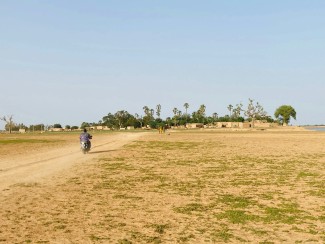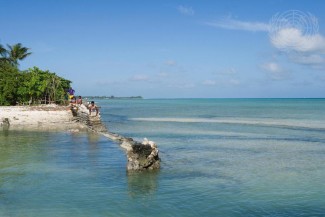EIF’s Deputy Executive Director discusses EIF’s just-launched Strategic Plan 2019-2022 and leaving no LDC behind
EIF has just released its Strategic Plan. What is new in the strategy and how is it evolving with EIF?
We are looking at deepening our work in various areas without necessarily changing our goals for Least Developed Countries (LDCs). And the goals are to improve the trade environment so there is inclusive and sustainable growth, and to increase exports and access to international markets.
But how do we improve the trade environment? We are looking at the second generation of trade mainstreaming, so to speak. One example is that we are going beyond our Diagnostic Trade Integration Studies (DTIS), which are our country-specific research and analysis, to looking at certain sectors within countries and how trade has been integrated into those different sectors. So with the analytical work there will be a much more focused approach to achieve our objectives.
We will deepen our focus on thematic issues related to youth, SMEs and women’s economic empowerment, and we will make sure our projects are targeted to those sectors where impact is linked to jobs and to incomes.
We are also looking at strategic value chains, targeting sectors for export competitiveness and economic potential. We will focus on actors across value chains so that we can ensure countries become more competitive for purposes of export.
Why is it important to address value chains?
We recognize that there are different actors along the value chain and if you target support to only one aspect of the chain then that chain can be kind of broken. We need to focus on all aspects, meaning on producers, on the middle tier, on the private sector, and on governments that are involved in policy formulation and implementation.
EIF has been supporting producers, making sure they have the technology, ensuring they have the training, ensuing that we have addressed standards issues. But if production is going to increase without accompanying export potential, it means we haven’t achieved our objective of export competitiveness. So beyond focusing on producers we are now looking at cooperatives that are involved in marketing. We are looking at firms that are involved in taking produce from coops and exporting. We are looking at packaging. We are looking at ensuring that countries are actually exposed to the opportunities in international markets.
EIF has a revalidated Theory of Change embedded in its new strategy. Can you elaborate?
We’ve had a reflective process to learn from our past experience and also to try and explore how the assumptions have played out. Out of that process of learning and evaluation that involved countries, our development partners, our funding partners and agencies, the process enabled us to have a fresh understanding and perspective to our Theory of Change.
We’ve revisited our assumptions. We’ve learned that national ownership remains important for countries to be able to make the transition. We’ve also learned that policies need to be implemented effectively – it’s one thing to have the development of policies but if they’re not implemented than that’s a problem. In countries where it has worked we’ve seen better results as far as policies translated into actual results.
We’ve learned that it’s important to ensure that all sectors of the economy are taken into account. For example special interest groups, youth and women. So this whole process of refreshing and reflecting on our accomplishments has helped us then to reflect this new thinking in our Theory of Change.
Now it’s very clear to see the link between our Strategic Plan’s goals and objectives all the way to the main outcome at impact level, which is that LDCs are empowered to use trade for sustainable development and for poverty reduction.
It’s been a really useful process as we have also been able to identify the other actors involved in our work on trade because there are certain areas where we will influence and there are certain other areas that are going to be influenced by other actors, so we have a better understanding of who else is involved and what they bring to the trade table.
One of the new elements in EIF’s strategy is a focus on fragile and conflict-affected countries. Can you tell me more about this emphasis and how it will be implemented?
We will focus mainly on supporting change in fragile and conflict-affected countries and working with other partners on the ground. We will be more flexible in how we derive and implement projects because we understand that situations evolve quite quickly in countries.
We will collaborate with non-traditional partners like civil society or the private sector if they are active on the ground and understand the political and economic issues. They key is to ensure the system keeps evolving and doesn’t stop.
In the end we want to ensure that we leave no country behind.
What else is new?
I think we’ve been very clear on the results that we want to achieve from this Strategic Plan. We’ve also been very clear on our implementation approach and what we are going to do differently. We will be prompt and flexible in our delivery and we are shifting away from the ‘tier’ approach to a much broader mechanism where we focus on outcomes.
We’ve also proposed new mechanisms for funding, for targeting thematic issues so we can encourage more participation, and of course ensuring there is country ownership.
Any final comments on EIF’s goals and objectives?
Our first goal is that our program improves the trade environment for inclusive and sustainable growth. Fulfilling the objectives under this might be a bit of institutional capacity work, it might be a bit of productive capacity work, it could be a feasibility study, it could be many things. As long as we’re clear on what that outcome will be.
Our second goal is to increase exports and access to international markets. So in achieving the objectives it might be something on institutional capacity work, it might be something on a strategic value chains, it could be technology, it could be leveraging resources. So we’re trying to be more focused on our broad goals for maximum impact.
The Plan was officially launched in Kampala, Uganda, by Minister of Trade, Industry and Cooperatives Amelia Kyambadde on 21 February 2019. See the Strategic Plan 2019-2022 here.
If you would like to reuse any material published here, please let us know by sending an email to EIF Communications: eifcommunications@wto.org.



